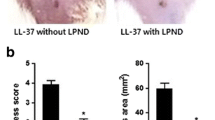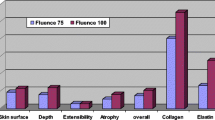Abstract
Background
Localized scleroderma (morphea) is characterized by hardening and thickening of the dermis due to excessive collagen deposition. A decreased number of CD34+ cells and an increased number of Factor XIIIa+ cells are seen in the affected skin. The flashlamp pulsed dye laser (FLPDL) has been used in the treatment of localized morphea with promising results.
Objective
The purpose of this study was to evaluate the therapeutic effectiveness of the pulsed dye laser in localized scleroderma and to assess its effect on CD34+ cells, Factor XIIIa+ cells, and blood vessels.
Study Design
Thirty patients with plaque morphea were treated with a FLPDL (585 nm wavelength, 450 μs pulse duration). Fluence ranged from 7.5 to 8.5 J/cm2. Sessions were performed biweekly for a maximum of 6 months. Clinical, histopathologic, and immunohistochemical assessments were performed.
Results
Patients showed varying degrees of improvement of indurated skin. There was no worsening or further improvement at the treated sites during the follow-up assessments at 3, 6, and 12 months. An increased number of CD34+ cells were found in both the upper and the lower dermis, and a decreased number of Factor XIIIa+ cells were found in the lower dermis.
Conclusion
The FLPDL is effective in the treatment of morphea, as confirmed by the changes in the pathologic tissue and levels of CD34+ and Factor XIIIa+ cells.


Similar content being viewed by others
References
De Rie MA, Bos JD. Photo-chemotherapy for systemic and localized scleroderma. J Am Acad Dermatol. 2000;13:725–6.
Skobieranda K, Helm F. Decreased expression of the human progenitor cell antigen (CD34) in morphea. Am J Dermatopathol. 1995;17:471–5.
Headington JT, Cerio R. Dendritic cells and the dermis. Am J Dermatopathol. 1990;12:17–20.
Anderson RP, Parrish JA. Precise microsurgery by selective absorption of pulsed radiation. Science. 1983;220:524–7.
Alster TS, Williams CM. Treatment of keloid sternotomy scars with 585 nm flash lamp pumped pulsed dye laser. Lancet. 1995;345:1198–200.
Alster TS, McMeekin TO. Improvement of facial acne scars by the 585 nm flash lamp pumped pulsed dye laser. J Am Acad Dermatol. 1996;35:79–81.
Eisen D, Alster TS. Use of a 585 nm pulsed dye laser for treatment of morphea. Dermatol Surg. 2002;28:615–6.
Camacho NR, Sanchez JE, Martin RF. Medium-dose UVA-1 phototherapy in localized scleroderma and its effect in CD 34-positive dendritic cells. J Am Acad Dermatol. 2001;45:697–9.
Jaworsky C. Connective tissue disease. In: Elder D, Elenitas R, Jaworsky C, et al., editors. Lever’s histopathology of the skin. 8th ed. Philadelphia: Lippincott-Raven; 1997. p. 274–8.
Adams EJ, Green JA, Clark AH. Comparison of different scoring systems for immunohistochemical staining. J Clin Pathol. 1999;52(1):75–7.
Rowell NR, Goodfield MJ. Connective tissue disorders. In: Champion RH, Burton JL, Burns DA, et al., editors. Textbook of dermatology. 6th ed. Oxford: Blackwell Science; 1998. p. 2502.
Orringer JS, Voorhees JJ, Hamilton T. Dermal matrix remodeling after nonablative laser therapy. J Am Acad Dermatol. 2005;53(5):775–82.
Kreuter A, Hyun J, Stucker M, et al. A randomized controlled study of low-dose UVA-1, and narrow-band UVB phototherapy in the treatment of localized scleroderma. J Am Acad Dermatol. 2006;54:440–7.
Cerio R, Griffiths CME, Cooper KD. Characterization of factor XIIIa positive dermal dendritic cells in normal and inflamed skin. Br J Dermatol. 1989;121:421–32.
Sehgal VN, Srivastava G, Aggarwal AK. Localized scleroderma/morphea. Int Soc Dermatol. 2002;41:467–75.
Acknowledgments
No sources of funding were received to prepare this study. The authors have no conflicts of interest directly relevant to the content of this study.
Author information
Authors and Affiliations
Corresponding author
Rights and permissions
About this article
Cite this article
Tawfik, A.A., Shokir, H., Soliman, M. et al. Pulsed Dye Laser in the Treatment of Localized Scleroderma and Its Effects on CD34+ and Factor XIIIa+ Cells: An Immunohistochemical Study. Am J Clin Dermatol 14, 235–241 (2013). https://doi.org/10.1007/s40257-013-0027-7
Published:
Issue Date:
DOI: https://doi.org/10.1007/s40257-013-0027-7




